Understanding the Human Communication Process: A Case Study
VerifiedAdded on 2023/06/15
|5
|980
|462
Essay
AI Summary
This essay explores the human communication process within a formal organizational setting, specifically a board meeting. It identifies and analyzes key elements of the communication model, including the source (C.E.O), receiver (board members), message, channel, noise, feedback, and situational/cultural contexts. The essay provides a detailed example of how these elements interact, such as the impact of noise (e.g., interruptions) and context (e.g., boardroom setting) on the effectiveness of communication. It emphasizes the importance of optimizing each element to ensure the clear and impactful delivery of the intended message, arguing that even strong language skills are insufficient without adherence to the communication model's requirements. The essay concludes by highlighting the necessity for organizers of communication processes to carefully manage these elements for optimal message delivery.
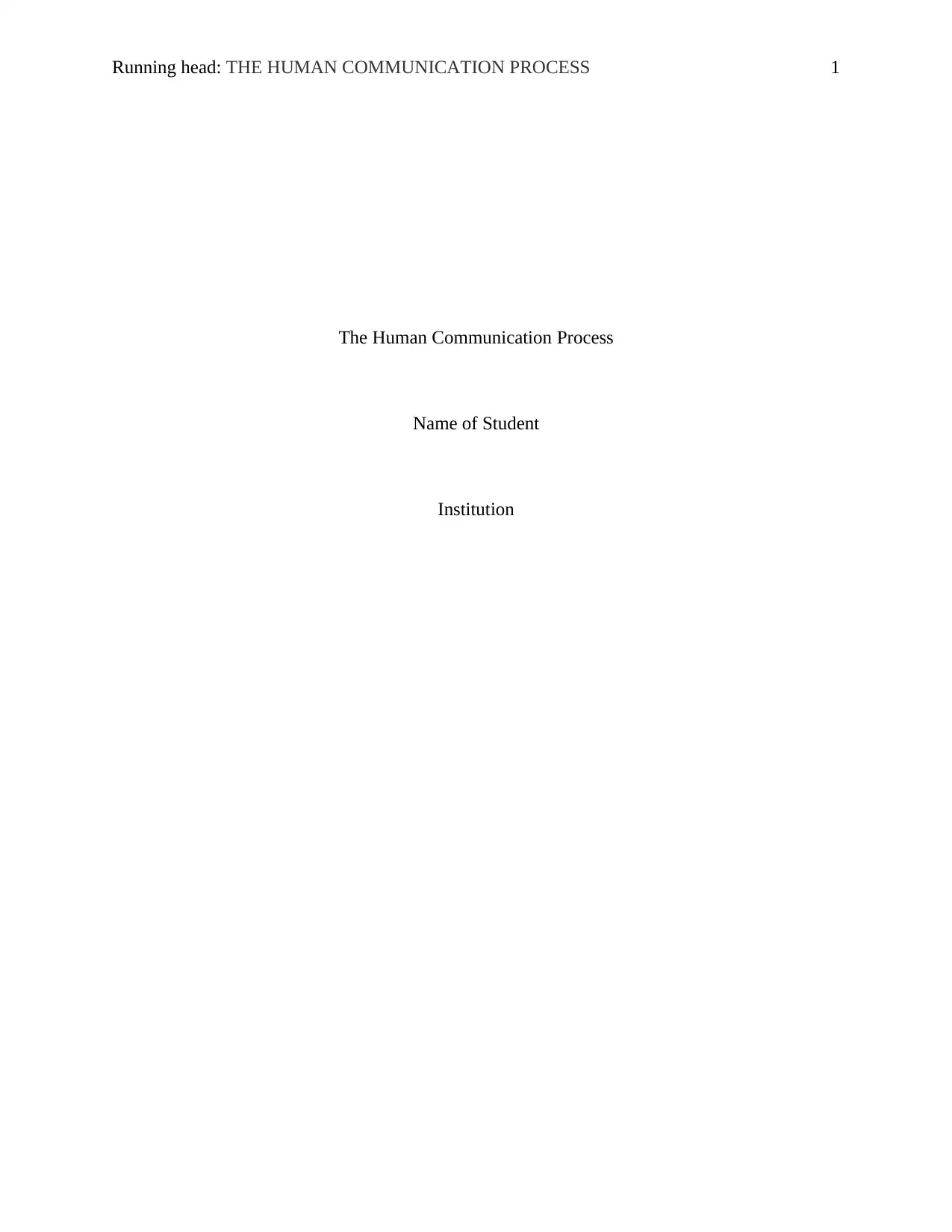
Running head: THE HUMAN COMMUNICATION PROCESS 1
The Human Communication Process
Name of Student
Institution
The Human Communication Process
Name of Student
Institution
Paraphrase This Document
Need a fresh take? Get an instant paraphrase of this document with our AI Paraphraser
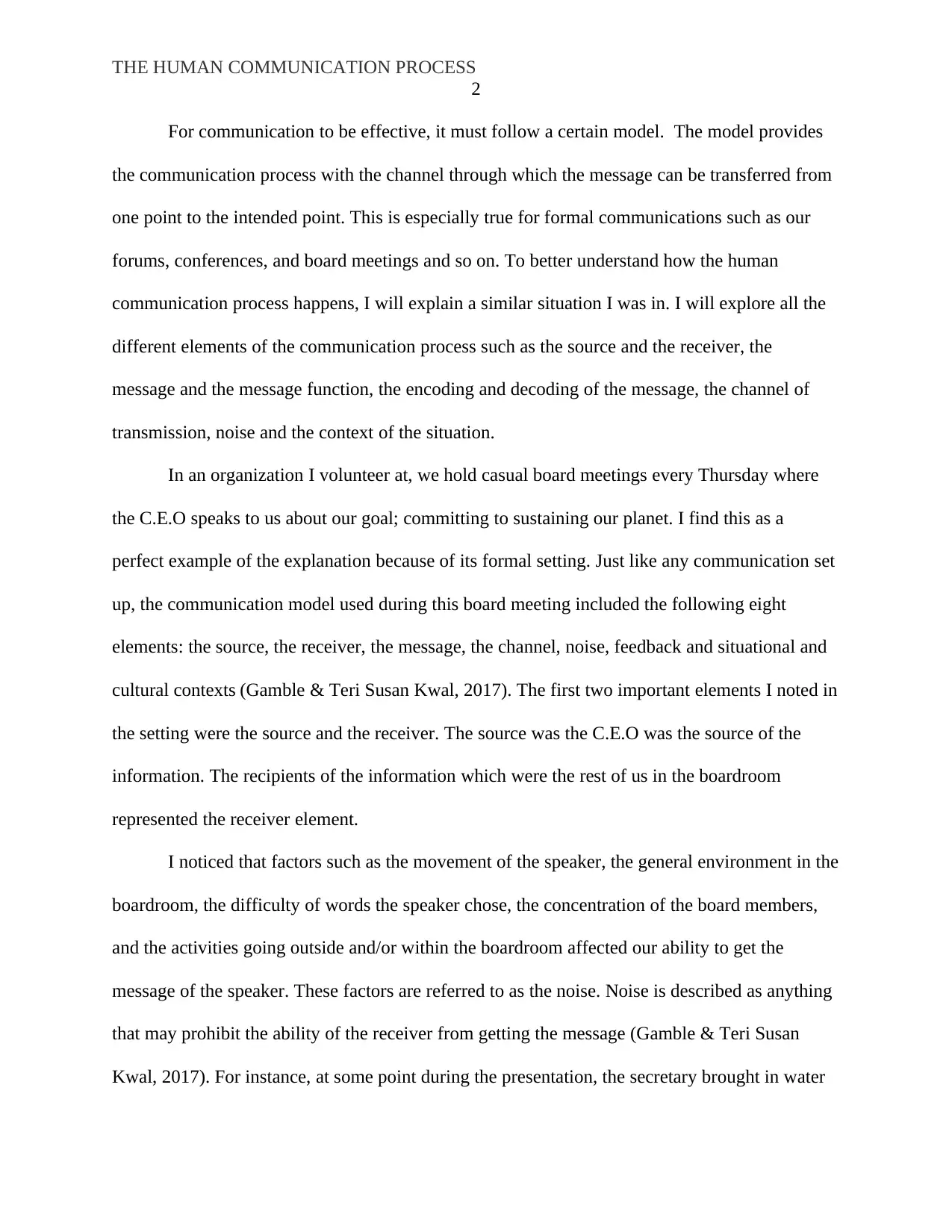
THE HUMAN COMMUNICATION PROCESS
2
For communication to be effective, it must follow a certain model. The model provides
the communication process with the channel through which the message can be transferred from
one point to the intended point. This is especially true for formal communications such as our
forums, conferences, and board meetings and so on. To better understand how the human
communication process happens, I will explain a similar situation I was in. I will explore all the
different elements of the communication process such as the source and the receiver, the
message and the message function, the encoding and decoding of the message, the channel of
transmission, noise and the context of the situation.
In an organization I volunteer at, we hold casual board meetings every Thursday where
the C.E.O speaks to us about our goal; committing to sustaining our planet. I find this as a
perfect example of the explanation because of its formal setting. Just like any communication set
up, the communication model used during this board meeting included the following eight
elements: the source, the receiver, the message, the channel, noise, feedback and situational and
cultural contexts (Gamble & Teri Susan Kwal, 2017). The first two important elements I noted in
the setting were the source and the receiver. The source was the C.E.O was the source of the
information. The recipients of the information which were the rest of us in the boardroom
represented the receiver element.
I noticed that factors such as the movement of the speaker, the general environment in the
boardroom, the difficulty of words the speaker chose, the concentration of the board members,
and the activities going outside and/or within the boardroom affected our ability to get the
message of the speaker. These factors are referred to as the noise. Noise is described as anything
that may prohibit the ability of the receiver from getting the message (Gamble & Teri Susan
Kwal, 2017). For instance, at some point during the presentation, the secretary brought in water
2
For communication to be effective, it must follow a certain model. The model provides
the communication process with the channel through which the message can be transferred from
one point to the intended point. This is especially true for formal communications such as our
forums, conferences, and board meetings and so on. To better understand how the human
communication process happens, I will explain a similar situation I was in. I will explore all the
different elements of the communication process such as the source and the receiver, the
message and the message function, the encoding and decoding of the message, the channel of
transmission, noise and the context of the situation.
In an organization I volunteer at, we hold casual board meetings every Thursday where
the C.E.O speaks to us about our goal; committing to sustaining our planet. I find this as a
perfect example of the explanation because of its formal setting. Just like any communication set
up, the communication model used during this board meeting included the following eight
elements: the source, the receiver, the message, the channel, noise, feedback and situational and
cultural contexts (Gamble & Teri Susan Kwal, 2017). The first two important elements I noted in
the setting were the source and the receiver. The source was the C.E.O was the source of the
information. The recipients of the information which were the rest of us in the boardroom
represented the receiver element.
I noticed that factors such as the movement of the speaker, the general environment in the
boardroom, the difficulty of words the speaker chose, the concentration of the board members,
and the activities going outside and/or within the boardroom affected our ability to get the
message of the speaker. These factors are referred to as the noise. Noise is described as anything
that may prohibit the ability of the receiver from getting the message (Gamble & Teri Susan
Kwal, 2017). For instance, at some point during the presentation, the secretary brought in water
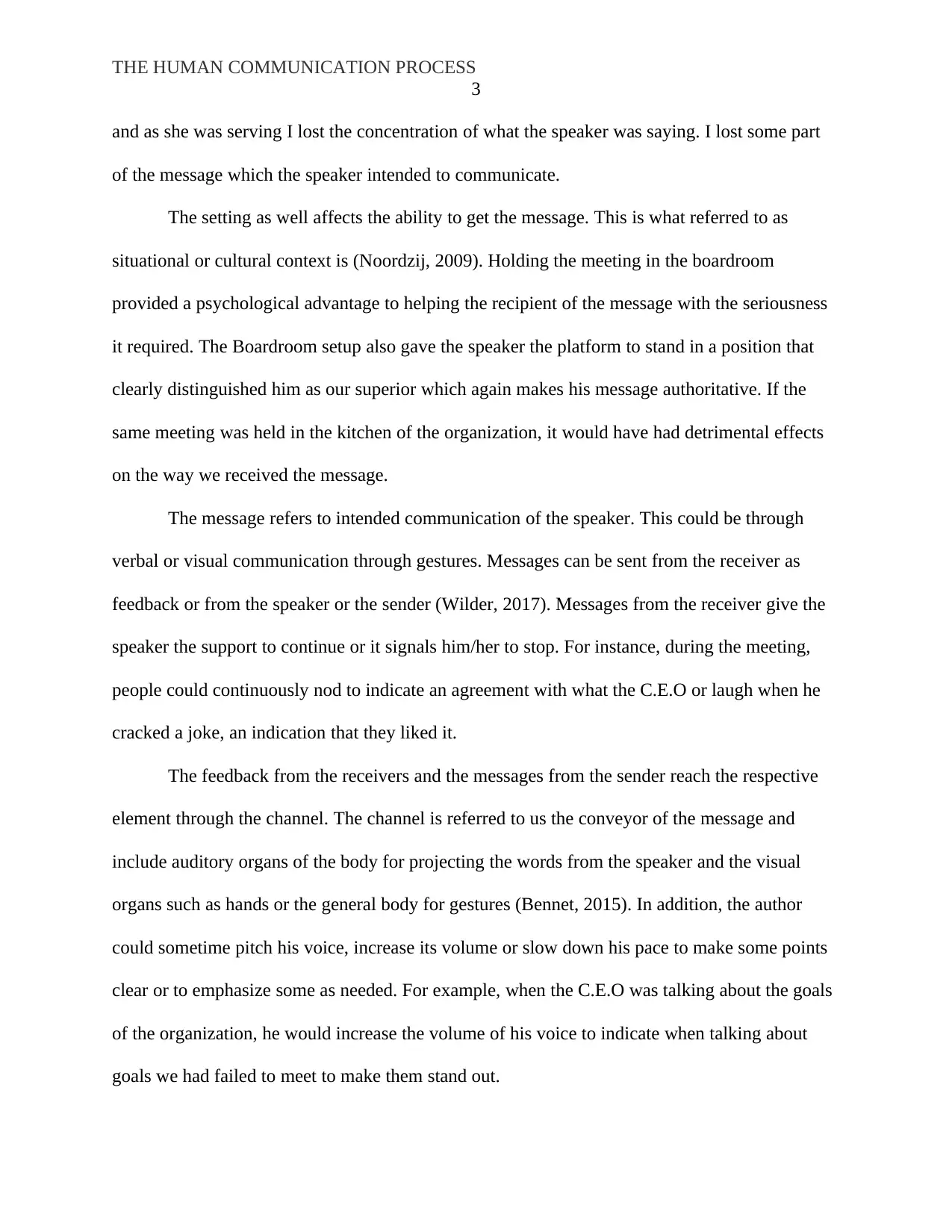
THE HUMAN COMMUNICATION PROCESS
3
and as she was serving I lost the concentration of what the speaker was saying. I lost some part
of the message which the speaker intended to communicate.
The setting as well affects the ability to get the message. This is what referred to as
situational or cultural context is (Noordzij, 2009). Holding the meeting in the boardroom
provided a psychological advantage to helping the recipient of the message with the seriousness
it required. The Boardroom setup also gave the speaker the platform to stand in a position that
clearly distinguished him as our superior which again makes his message authoritative. If the
same meeting was held in the kitchen of the organization, it would have had detrimental effects
on the way we received the message.
The message refers to intended communication of the speaker. This could be through
verbal or visual communication through gestures. Messages can be sent from the receiver as
feedback or from the speaker or the sender (Wilder, 2017). Messages from the receiver give the
speaker the support to continue or it signals him/her to stop. For instance, during the meeting,
people could continuously nod to indicate an agreement with what the C.E.O or laugh when he
cracked a joke, an indication that they liked it.
The feedback from the receivers and the messages from the sender reach the respective
element through the channel. The channel is referred to us the conveyor of the message and
include auditory organs of the body for projecting the words from the speaker and the visual
organs such as hands or the general body for gestures (Bennet, 2015). In addition, the author
could sometime pitch his voice, increase its volume or slow down his pace to make some points
clear or to emphasize some as needed. For example, when the C.E.O was talking about the goals
of the organization, he would increase the volume of his voice to indicate when talking about
goals we had failed to meet to make them stand out.
3
and as she was serving I lost the concentration of what the speaker was saying. I lost some part
of the message which the speaker intended to communicate.
The setting as well affects the ability to get the message. This is what referred to as
situational or cultural context is (Noordzij, 2009). Holding the meeting in the boardroom
provided a psychological advantage to helping the recipient of the message with the seriousness
it required. The Boardroom setup also gave the speaker the platform to stand in a position that
clearly distinguished him as our superior which again makes his message authoritative. If the
same meeting was held in the kitchen of the organization, it would have had detrimental effects
on the way we received the message.
The message refers to intended communication of the speaker. This could be through
verbal or visual communication through gestures. Messages can be sent from the receiver as
feedback or from the speaker or the sender (Wilder, 2017). Messages from the receiver give the
speaker the support to continue or it signals him/her to stop. For instance, during the meeting,
people could continuously nod to indicate an agreement with what the C.E.O or laugh when he
cracked a joke, an indication that they liked it.
The feedback from the receivers and the messages from the sender reach the respective
element through the channel. The channel is referred to us the conveyor of the message and
include auditory organs of the body for projecting the words from the speaker and the visual
organs such as hands or the general body for gestures (Bennet, 2015). In addition, the author
could sometime pitch his voice, increase its volume or slow down his pace to make some points
clear or to emphasize some as needed. For example, when the C.E.O was talking about the goals
of the organization, he would increase the volume of his voice to indicate when talking about
goals we had failed to meet to make them stand out.
⊘ This is a preview!⊘
Do you want full access?
Subscribe today to unlock all pages.

Trusted by 1+ million students worldwide
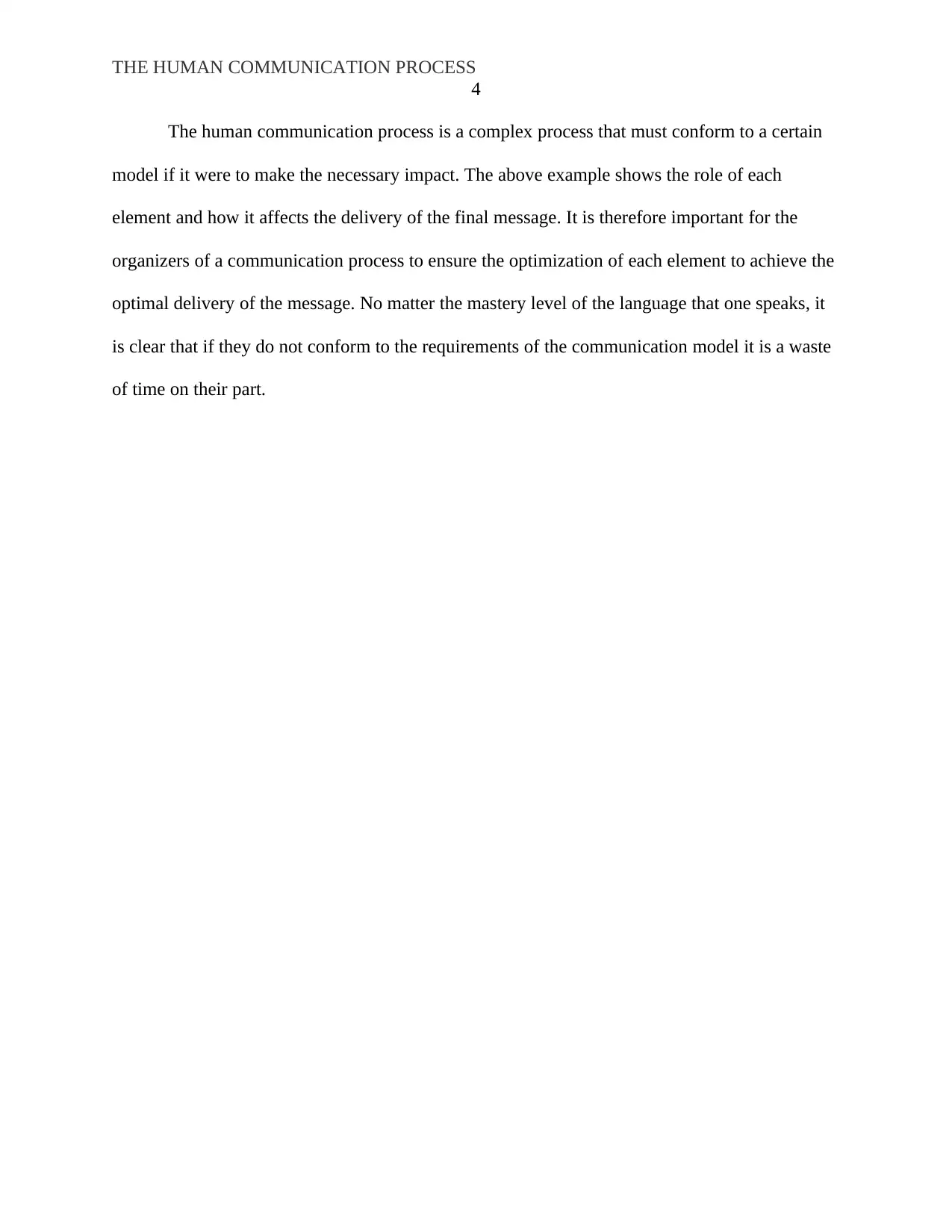
THE HUMAN COMMUNICATION PROCESS
4
The human communication process is a complex process that must conform to a certain
model if it were to make the necessary impact. The above example shows the role of each
element and how it affects the delivery of the final message. It is therefore important for the
organizers of a communication process to ensure the optimization of each element to achieve the
optimal delivery of the message. No matter the mastery level of the language that one speaks, it
is clear that if they do not conform to the requirements of the communication model it is a waste
of time on their part.
4
The human communication process is a complex process that must conform to a certain
model if it were to make the necessary impact. The above example shows the role of each
element and how it affects the delivery of the final message. It is therefore important for the
organizers of a communication process to ensure the optimization of each element to achieve the
optimal delivery of the message. No matter the mastery level of the language that one speaks, it
is clear that if they do not conform to the requirements of the communication model it is a waste
of time on their part.
Paraphrase This Document
Need a fresh take? Get an instant paraphrase of this document with our AI Paraphraser
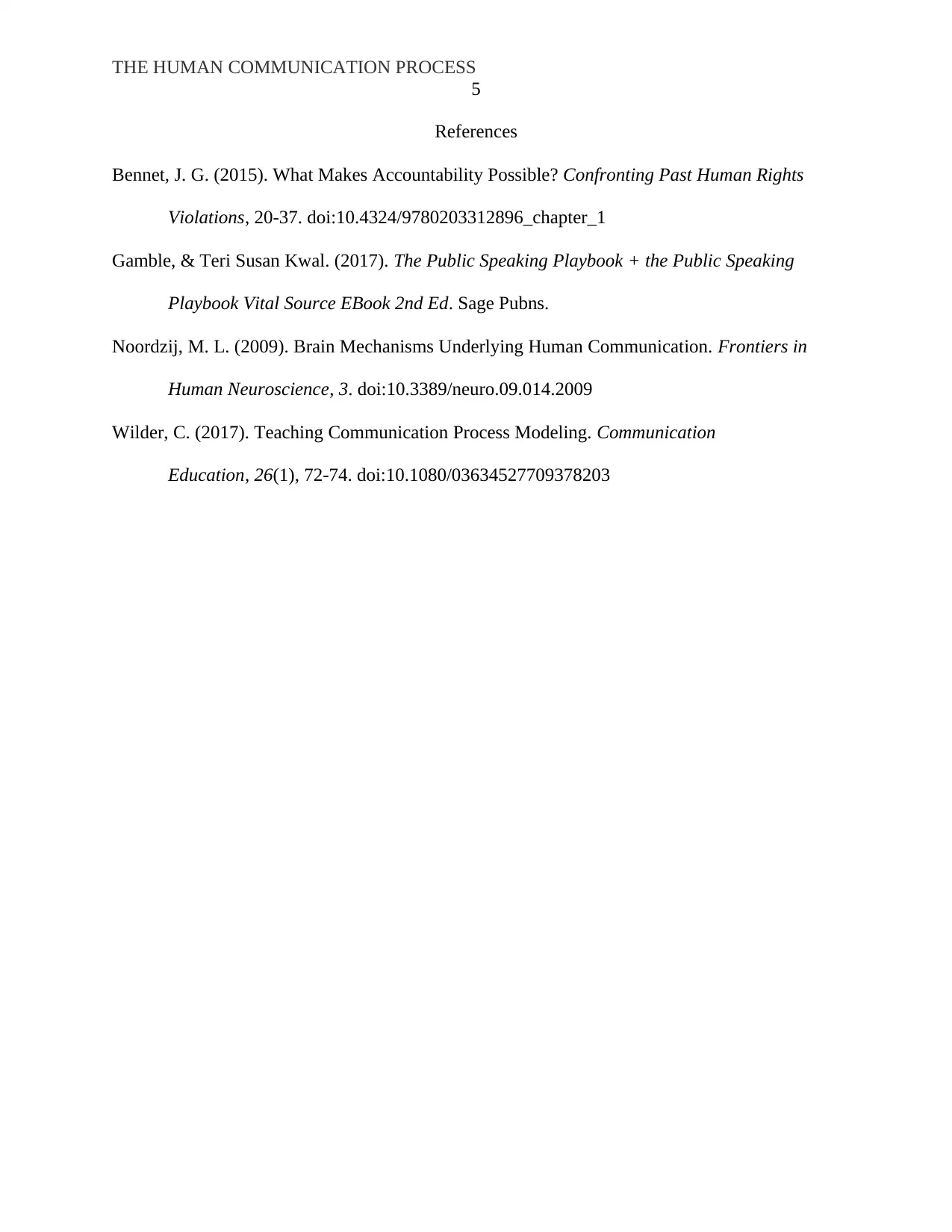
THE HUMAN COMMUNICATION PROCESS
5
References
Bennet, J. G. (2015). What Makes Accountability Possible? Confronting Past Human Rights
Violations, 20-37. doi:10.4324/9780203312896_chapter_1
Gamble, & Teri Susan Kwal. (2017). The Public Speaking Playbook + the Public Speaking
Playbook Vital Source EBook 2nd Ed. Sage Pubns.
Noordzij, M. L. (2009). Brain Mechanisms Underlying Human Communication. Frontiers in
Human Neuroscience, 3. doi:10.3389/neuro.09.014.2009
Wilder, C. (2017). Teaching Communication Process Modeling. Communication
Education, 26(1), 72-74. doi:10.1080/03634527709378203
5
References
Bennet, J. G. (2015). What Makes Accountability Possible? Confronting Past Human Rights
Violations, 20-37. doi:10.4324/9780203312896_chapter_1
Gamble, & Teri Susan Kwal. (2017). The Public Speaking Playbook + the Public Speaking
Playbook Vital Source EBook 2nd Ed. Sage Pubns.
Noordzij, M. L. (2009). Brain Mechanisms Underlying Human Communication. Frontiers in
Human Neuroscience, 3. doi:10.3389/neuro.09.014.2009
Wilder, C. (2017). Teaching Communication Process Modeling. Communication
Education, 26(1), 72-74. doi:10.1080/03634527709378203
1 out of 5
Your All-in-One AI-Powered Toolkit for Academic Success.
+13062052269
info@desklib.com
Available 24*7 on WhatsApp / Email
![[object Object]](/_next/static/media/star-bottom.7253800d.svg)
Unlock your academic potential
Copyright © 2020–2025 A2Z Services. All Rights Reserved. Developed and managed by ZUCOL.

